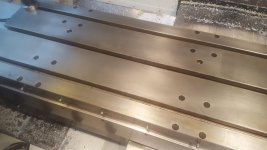Matt@RFR
Titanium
- Joined
- May 26, 2004
- Location
- Paradise, Ca
There are a shit ton of threads talking about corrosion between machine tables and aluminum sub plates. To the best of my searching ability, nobody has ever shown pictures of actual results after some time... Until now!
Haas VF-2
6061 Sub plate, raw machined surface on table
Pretty sure I put a very thin layer of motor oil on the table
3.5 years:


Obviously we've scraped all the chips and loose rust out in the picture of the table, but no real cleaning has been done at all. There is actually ZERO corrosion at the interface around all the bolts. It's only in between the bolts where there is slight corrosion, but I'm super happy with this. After repairs (stupid X axis...) it's going to get put back together exactly as before.
But wait! There's more! After 3M pad cleaning:


And some pitting in the T-slot sections:

Haas VF-2
6061 Sub plate, raw machined surface on table
Pretty sure I put a very thin layer of motor oil on the table
3.5 years:


Obviously we've scraped all the chips and loose rust out in the picture of the table, but no real cleaning has been done at all. There is actually ZERO corrosion at the interface around all the bolts. It's only in between the bolts where there is slight corrosion, but I'm super happy with this. After repairs (stupid X axis...) it's going to get put back together exactly as before.
But wait! There's more! After 3M pad cleaning:


And some pitting in the T-slot sections:



